| Home | |
| Adventures | |
| Specification | |
| Diary | |
| Photo Album | |
| Contact Us | |
| Feedback | |
| Hints & Tips | |
| Polish Words | |
| Web links | |
| Problem | |
| Polish Yachts | |
Rudder completed enough to fit. Cockpit well sides fitted. Dropboards made. June/July 1994.
4/6/94
Arrived mid-day one caravan there on the only level spot there is in the field. Underneath a tree as well. Never saw anyone until 20:00pm. Wet, windy, cold and damp. No comparison to last weekend. All seemed intact. Set to belt-sanding down the covering boards. Then brushed down the whole deck, Must be spider season there are cobwebs everywhere. Then cut to length and shaped the aft port and starboard covering board ends. These had to be left until last to give us some extra leverage whilst fixing into place. So damp today difficult to get into the swing. Paid rent and Electric to Les H, and asked Les H and he has kindly lent us the large and small block and tackle to assist in moving the boat. When the caravanners returned they walked over to the boundary fence nosing into the neighbours garden at the pigs and the hens. They are only humans inquisitive. Sanded down the after most pieces of covering boards.
5/6/94
Warm , sunny start. John H here to cut more grass. Caravanners gone out. Set to sanding down the rest of the covering boards. This done will need a longish piece of ply narrow with a length of sandpaper on to finally even off the boards. Only slight unevenness, more due to the shaping/twisting of the timber. Assessed the forward king plank situation. In the inner cockpit area we sanded down the ply inserts and beams to remove dust, dirt, epoxy drips and whatever else. It needed doing anyway - and will need it again before the deck ply is stuck down. By 15:00pm tidied up and set off to search out another Boat Builders who had a yard and moorings along the canal. Found it no problem. Owners not there at weekends, but a chap said there is a two year waiting list for moorings. He had had his boat in the yard for 4 years. There is two yards one is more exposed than the other. No good.
6/6/94 10/6/94
Dug out the rudder shaft, ply pieces and stainless steel metal lengths and rudder shoe and laid it all out in the lounge. Got out the welding gear and welded more of the metal lengths, in the garden of course. We had decided to weld on more stainless steel and extend the frame. Never underestimate the power of the sea.
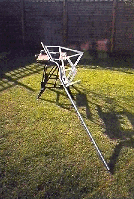 |
Left is the rudder frame after extra pieces welded onto it. Right is the rudder frame as it was originally |
 |
Dug out some wood places from the yellow pages and we visited several of the local builders merchants, and telephoned others. For the oak for the rudder we are looking at £160-£200 + vat. 6 lengths x 63" x 10" x 1 Ό" @ £2.75cubic foot. It is more expensive than teak.! Need to visit the chandlery for some copper/bronze rivets/nails for the rudder shoe. Or should we use stainless steel bolts.?. There is a lot of pressure on the rudder shoe. Maybe do a mixture of fittings.
11/6/94
Gary Hs boat gone and the area does look tidy now. With regards to the rudder sped off straight to the chandlery. They hardly had any copper nails left. No more round ones certainly. Chaps not sure if they are still available. Anyway found some 3" square copper nails. Weighed 100 just over a kilo - £24. Wow . Golly gosh!. Chap asked how many we wanted cheaper deal if needed more. In the end we settled for 200 at £30. Also asked him re hard standing. £61.69 per month inclusive of vat, electric and water. Had a good look around at the possibility before leaving. It could be a squash for parking and working etc but it is cheaper. Took off to the boat and time for a cup of tea. No one there not even any caravans. Bliss. Heat was tremendous though. 22degrees on boat. Dropped the sheets, then after tea contemplated on all the work that still needs to be done. Made up a pattern for , and cut out of Ύ" ply the cockpit well side pieces, port and starboard. Decided not to use 12mm and use Ύ" instead for added strength to hold up the cockpit sole and support the remote morse control, insulation of heat and sound, and to stand up to large waves temporarily swamping the cockpit with water. What a weight the pieces of timber were. About 40" x 40" x Ύ" . Imagine lifting them in and out of the cockpit, up and off the boat several times. We did just that. Both of us really satisfied we have used this plywood. Tidied up and left for drink and eats.
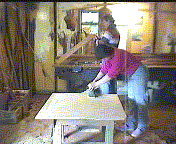 |
||
| 3/4" ply cockpit well portside piece |
12/6/94
Good day weatherwise today. Planed up two lengths of mahogany to form battening inside the main cabin, and covering the 'bridge deck' bulkhead joints between the outer pieces and the center piece. Decision over the edging because we do not know yet the height of sink or layout of the chart table etc. Decided to use same curved router bit as for the covering boards. Sanded down both faces of the cockpit well ply pieces cut out yesterday. Hard work climbing in and out of the cockpit well without the sole in. it is about a 4 ½ drop into the bilges. Beats keep fit any day. Also removed the paper in the shed roof to allow more fresh air through cool air hopefully. By 15:00pm the temporary companionway steps into the boat had been unscrewed from the cockpit bulkhead. Needed to shorten the 2"x1" which had been holding up the steps to be clear of this bulk-head joint. Problem was once unscrewed the steps no-one could get in or out of the boat. Therefore Lance had to work on the inside, Ruth doing the unscrewing, supporting bulkhead and re screwing from inside the cockpit. A two person job. By 16:00pm tea time yet again. The portside bulkhead join covering board was screwed into place. This time Lance needed to work in the cockpit and Ruth hold the timber in place inside the main cabin. Need lighting now for any jobs inside the boat. Over the weekend also sanded down the main cabin roof outside to remove dirt and any epoxy drips. Used 8 x 1 Ό x 10 stainless steel screws on the portside bulkheads joining timber. Now to do the same starboard. Finished approx. 17:30pm. Packed for home after hoovering cockpit and main cabin.
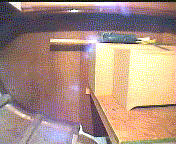 |
Aft main cabin bulk head, looking aft. Showing starboard beam in place for covering the join of the two bulkheads aside of the temporary companionway steps. Same type of beam put in place on the portside of the companionway steps. |
13/6/94 17/6/94
Did lot of hard work with the rudder, either in the lounge or in the back garden. Careful to use the grinder when all the neighbours were out. All lengths of stainless steel bar were cut to length using junior hacksaw experience told us it does the job best. These lengths were welded together onto the rudder frame. Attention was paid to the stress points above and below the joins in the shaft. If there is any fatigue in these areas the load needs to be transferred as much as possible via the frame. Also at the very top of the frame a piece of bar has been welded in place such that the gap between the fibreglass and the top of the rudder (metal strip) will be less than the gap between the bottom of the rudder and the bearing. This being so if the rudder hits anything and wears away the fibreglass and wood the stainless steel bar will prevent further erosion and stop the rudder shaft jumping out of the shoe. Lance got toasted on both sides of his body whilst welding. Sunburn on his back, and stripy weld-burn on his chest and face. Stripy because the weld flash caught him at a angle and consequently one can see lines where he had held his arm across his chest, and also where the mask went across his face. For this time of year the colour makes him look well although he feels very much otherwise. Contemplating sending John H and his wife a letter this week regarding moving our boat out. Needs more thought though. By Friday evening had routered out the rudder ply to accommodate the extra pieces of stainless steel bar added. Then out came all the epoxy gear and the sikaflex in the tube just did a covering of both sides of the bars. We epoxied both pieces of ply together 12 + 8 squirts. Then clamped the rudder ply all round the edges. Had not got clamps to reach the middle therefore had to hope it would even itself out. Peppy showed his approval when we brought the rudder inside. He sat right in the middle of it amidst all the clamps. He is very much part of the boat. Weather has been very hot all week.

|
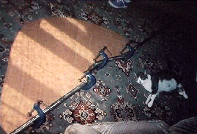
|
|
| Rudder framework about completed. | First two pieces of plywood, routered out and the rudder framework sandwiched between the ply. |
18/6/94
2nd week no caravans, so John H has brought his down. We had brought the rudder and tiller with us and first job was to sand down and clean up the sikaflex/epoxy. The hole under the boat was cleared out, and we fitted the rudder in place. It is a job and a half over a 5 hole, holding and trying to insert into the shaft tube, the rudder which feels like a ton weight and it is not finished yet. It looked massive on the lounge floor, but the boat swallows it up. It actually fits very well and looks a very smart shape. Will need just a touch taking off the very lower edge of the rudder, but otherwise an excellent job done, and one which gives a big boost in ego and achievement. Further work on the cockpit lockers bulkheads joints. Used a large thick piece of timber saved from the badly wood wormed piece. Not brilliant to plane but could get away with it as it is inside the lockers. The largest (tri) plane did the better job of tidying up the edges. Used the chamfered router bit to round the exposed edges. It makes a nice finish. Lots and lots of dust made with plane, saw and router. Kept doors shut and rear windows open to keep noise to a minimum. John H here burning twigs. By 20:00pm we had fitted port and starboard pieces of cockpit well side supports. Thought about asking John H today ref the boat move, he had been up for some matches for his fire!, but we left it for now. Used 14 x 2" stainless steel wood screws in battens.
19/6/94
Having now fitted in place all four battens for the inner cockpit locker sides, contemplated on the fixing of the bottom of the sides i.e. laminating to the Hull and then whether to try putting ply across the lower two stringers on top of which the cockpit sides will sit. Then possibly fill under the ply with expanding foam or the laminating foam. Decided it would be worth doing the ply in this instance. It will be better for insulation etc, and plying the hull inside, over expanding foam, was our original intention anyway. Made up pattern for this piece of starboard ply, then used Thames 8mm to cut a piece out. Hard work enough for us, not to mention jumping in and out of the cockpit well which is a 4/5 drop. Being careful at the same time not to slip down into the narrow bilges area. Used 1 ½" x 10 stainless steel screws to fix the cockpit starboard side ply in place to the new battens. Screwed into place the cockpit well sides. About 16:00pm John H and his other son called to pick up John Hs Caravan.

|

|
|
| Expanding foam filled the cavities between stringers | then plywood, cut to shape, fixed over the foam ensuring no gaps anywhere. |
25/6/94
Caravan here therefore decided not to make too greater noise. Do not want to develop an excuse to get us out by being a nuisance. (John H must have turned the water on for them though !). Unscrewed the cockpit sides and battens and hull ply. Brushed out the hull area then used 1 sheet 31" x 1 x 1"! Polyurethane foam starboard and 1 port, and using 2 part polyurethane expanding foam, laminated these foam sheets to the hull , and filled the gaps with foam to level it off with the stringers, ready for the ply to go back on. No foam is wasted. All the off-cuts are inserted in holes where foam is next to be used. Then with the sikaflex ran the stuff along the upper and lower edges of the stringers , onto which the ply will be screwed. Mixed up some expanding foam, spread it across the newly filled area then sandwiched the ply down on top. Quickly then screwed the ply down. Ply was awkward shape and would only go in one direction. Just when we needed to get it down fast it jams itself. Panic !. Panic!. The foam itself goes off and expands in seconds, if you are not careful it is expanding in all directions. Magic Stuff in use. Need gloves on though and oh the fumes when it expands is a knockout. Need double cups of tea now. By 20:30pm we had taken off the bulkhead joints battens and set out to epoxy these two in. Awkward needed to play monkeys again climbing in and out without full support of the steps. Lance worked with epoxy on the inside, Ruth in the cockpit. Drill at the ready. Both pieces were to be stuck at the same time same epoxy batch. Lance painted on the epoxy and held batten in place whilst Ruth shot the screws in with the electric drill. Then once both battens in place, we swapped places. Lance tightened the screws fully, then set to epoxy in the cockpit side battens there were 4 but we totally forgot the 2 aft ones. They will have to wait for the next time. Cleaned up the epoxy on the main cabin/cockpit bulkhead battens then climbed in the cockpit with Lance and proceeded to clean up there. Rubbed the plywood in the cockpit over with the acetone rag as well. That trace of epoxy will help to seal the timber. Now we have just cleaned up and tidied up. Neighbour is now having her routine bonfire and the wind is blowing directly onto the caravan in the middle of the field.
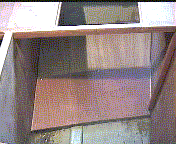
|

|
|
| 2nd plywood on expanding foam in place | view down inside portside cockpit locker, stood aft looking forward. |
26/6/94
The ply had gone down well. Assessed ideal cockpit floor situation in comparison with the anticipated water line. Should work well. What about the fuel tanks though. Are we getting one or two, and will they go through the hatch. Not forgetting the bolsan cables enter one of the lockers and needs to pass through. Should we latte the lockers out with mahogany, or paint them out white. Bearing in mind this area will not be able to be maintained very easily if at all. Therefore painting out in white or epoxy it white could be the best option, and put thin lattes over the plywood joints to cover the screws with gaps to allow water to pass down to drainage holes. By 16:30pm the next two pieces of ply had been cut, to adjoin the existing pieces. Will need to fix these likewise on expanding foam before cockpit sides are fixed in place. Need some more expanding foam and sheets. Measured up and cut pattern for hatch drop boards. Cut out a piece of 1" ply to shape. 1" just fitted right allowing for a sealing strip to be put on the inner side. The drop boards will need to be two pieces with a rebate to knit them together. Still 20 degrees at 18:00pm. Cut the drop board into two, and using the router, routered the upper and lower rebates in the two drop board pieces.

|
||
| Temporary Hatch drop boards made out two pieces of 1" plywood. |
Sometimes we get home and wonder what we have done all weekend ?. We value the video and diary to recap. Replenished the acetone tin and filler carton before leaving for home about 19:30pm
28/6/94
Visited Silvermans Timber for a piece of 1" x 8 x 4 marine plywood ANCHOR marine which is one of the best on the market today. 17 laminates used to make up the ply. It only set us back £180. Heart breaking. Set to cutting out the rudder pattern on this 1" ply. We will be able to get it out of ½ sheet. The rest could be used for the engine beds. Having cut the two pieces dust flying everywhere, then with the router routered the upper and lower edges of the shaft side of the ply. This means the ply will butt up to the shaft, and the chamfer on the upper edge will be close to the angle it should be as a finished thing. So far very good progress made. Now a lot of planing needs to be done to chamfer the ply to almost nothing at the outer edge. That was a very daunting thought. What we could have done with now is some epoxy etc. The ply will need sticking down before first planing is done.
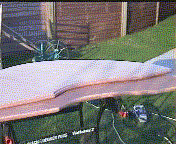
|

|
|
| 1" Marine Ply used to remake the Rudder. | Routered on the underside to fit snug up to the shaft. Routered on the upper side to be nearer to the finished edge. |
1/7/94
Took off to Wessex Resins only to arrive at 13:00pm their lunchtime. One lady was there- but not all that was required was in the front shop. Left our order with her and took off to Chandlery to get some rolls of Yellow Grit Paper etc, £24 went no-where. Then back to Wessex Resins. Decided to get some brushes and Glass cloth whilst here. £144 less we left for Strand Glass. We were doing well despite the heat only to get to Strand Glass and they were shut today for stock take !. Well blow us Why today. Just as well we got the brushes and cloth at Wessex Resins for now anyway. Quenched our thirst , then set to epoxying in place one side of the rudder. Not as easy as it sounded. Epoxy down the inner edge of the ply, two batches of resin and filler made up. Hardener added to one batch and this spread onto the new ply. Then just before that completed, mixed the hardener into the next batch. 10 Plunges in each batch. 2nd batch spread onto the rudder ply itself, and the two pieces sandwiched together and clamped. Then we realised what we forgot was the rudder ply was pre drilled for the stainless steel bars. Consequently under pressure the epoxy was oozing out of the holes underneath all over the floor. Quickly tissues scraped it up and as quick again newspaper down. What a messy job. Then to clean up with acetone the rudder edges because later the router will be ran along the edges to level this new ply up to the now centre ply. 17 clamps and lots of tissues piling up, clamp and clean up done now to turn the rudder over and clean up as much as possible in the holes, as once the epoxy gone off these holes need re drilling right through the new ply. This clean up done then returned to clean up the brush and pots. Brush had really been left too long and it went hard next day. Another one for the bin. Very, very humid this evening and mid evening had a thunderstorm and very heavy rain. The change of atmospheric pressure was phenomenal and we both felt uneasy, tired, and confused. Slept in the van until about 21:30pm and then decided to pop out for beer and eats.
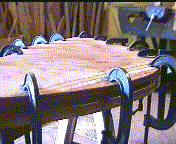
|

|
|
| Epoxying the plywood pieces together for the Rudder. | Closeup of Rudder showing sikaflex used around the shaft edge, once plywood epoxied into place. |
2/7/94
1st thing unclamped the rudder and re-drilled out the holes. Then took off to Strand Glass. Returned to the boat and caravanners about to go and John H and his wife here with their caravan and accessories, but outside their bottom workshop though, and plugged in to electric down there. Turning out another warm day. Prepared the next side of the rudder ply, and this time spread newspaper on the floor before we started. Same procedure, sikaflex and two batches of epoxy but only 8 + 9 plunges this time. Clamped up and cleaned up and then turned over to clean the holes. The new pot we bought yesterday the acetone had removed the markings on it !. Some help. We had been cleaning the pots with acetone, but decided now we will try leaving the small residue of epoxy in the pot until it has gone off, and then peel it out of the pot. Saves acetone in the cleaning process. All went well. Once epoxy almost gone off which was early evening the holes were drilled out. By evening the epoxy had gone off and removed the clamps. With the new epoxy resin and hardener poured the leftover old stuff into it. Quantity of resin at bottom of the container needed sun on it to soften it to enable pouring. Obviously it has been cold, and never warmed through enough at the bottom. Assessed the hull where the rudder fits, it all needs a good sand down to remove the paint and contamination. No sooner said and we set to work with 600 wet and dry. Not rough enough needed more but it is a start. Took a while sanding around the shaft/rudder area. Not easy when sanding stood at awkward angles underneath the hull, over a 5' hole.
3/7/94
Yet another hot and sticky day. John H packed up caravan and left. We set to planing down the rudder. What a long job this was going to be. Started sanding down the portside of the hull near the rudder/shaft. Enthusiasm needed to be kept up now, teas made regularly, door shut whilst using the electric planer and belt sander etc. The planing started. Lots of sawdust made and still there was lots more planing to be done. Not as much as when we started though. The fact it was ply made the job easier as the laminates showed through like stripes. Thinking one side to plane was bad enough , but the other side was to be done to match identical. The lines of the laminates are looking like contours on an ordnance survey map. The closer together the steeper the gradient. Hoovered up the workshop and bagged the shavings from the rudder. Also rent was paid and we mentioned to Les H re the rent situation, we could pay it to John H and pay £10 to Les H for use of the tools etc and John H allow us to stay until next April/May 95. Les H was happy regarding the money situation and would speak to John H, no promises. We continued planing away on the rudder. Chamfered off the inner edge further, rounded off the uppermost edge near the shaft, then chamfered likewise for the propeller, as the hull is shaped. Lots and lots of dust. All epoxy gear in the van again. 19:30pm and just stopped planing and sanding. Rudder still not finished but it is well underway. Slightly lighter in weight now. 20:30pm and we had just tried the rudder. What a job and a half to finish with. But an excellent day we had had. Took the rudder home with us.

|
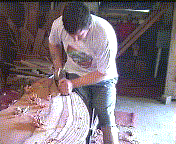
|

|
| Both sides of the Rudder needed to be planed and sanded down identical. |
Many, many hours of hard work needed to plane the rudder to
shape.
|
Planing and sanding almost completed. It is looking very very attractive, and practical. |
4/7/94 thru 8/7/94
We had the rudder in the garden, and the lounge. We had brought home the tressles out of the workshop. The extent of work this week was further sanding and shaping. Sanding was tedious and once completed then set to driving in and peeling over 78 copper nails square. This was done on the living room floor. Bang, Bang, Bang. As much as possible whilst the neighbours were out. Peeling over was very tedious. Using the clinching dolly underneath as pressure on nail head, whilst snipped and peeled over the opposite end. All 78 nails done Wednesday and Thursday. Friday decided to run sikaflex down one edge of the rudder where the ply meets the shaft. This would close the gap up better, and give more adhesion surface for the laminating epoxy.
10/7/94.
Positively decided to continue with rudder at home, and get some epoxying done. Weather ideal for it. Set up the tressles, with polythene over the lawn to catch the epoxy. The wind too strong to keep newspaper down. Rudder given a final sanding down. Set to epoxying on the first layer of fibreglass matting on one side. Was going to do a layer of epoxy first to fill the nail head voids. But decided to go ahead and do a first matting and ensure the holes were filled. 4 pieces of matting were cut on and first layer of matting placed on the rudder with weights to hold it in place namely some tools. It took time to spread it out evenly and then use short strips of masking tape just catching the edges to hold it in place. A mix of 5 plunges made of epoxy only. This was poured onto the matting and spread out with a squeegy. Once it was nearly all spread, Ruth mixed 4 plunges more of expoxy and this was spread on the matting. At last moment used a brush to do the final strokes and as we realised after the 1st side done, air bubbles were generated over the nail heads. On doing the 2nd coat made sure the air bubbles were dispersed. Both sides cured in about an hour. Sun was helping enourmously. Now to do the edging strip. This was a plavava. Cut a length of glass tape ready. Epoxy was mixed. The rudder was held upright and just as we were about to start, wind caught end of tape, as we caught it , it caught on the tressle pulling a thread. In straightening it out time was being lost and the epoxy was going off. Sure enough not even a quarter way done and smoke belched from the epoxy pot, brush becoming stiff, any moment about to erupt in flames. We tipped out the residue on the soil then left the pot to its own devices and mixed a fresh lot. As the rudder edge is shaped, tape has to be glassed onto the edge surface, then bent over the sides both sides. With the curvature as well creases in the tape would not all disperse and had to be snipped off, then dabbed with the brush. It is 18:30pm now and we have epoxied the rest of the outer edge. Next is the rudder shaft edge. Two brushes rendered useless today. Brushes need cleaning before the curing starts, otherwise it will not thin out. Good job we bought 10 last weekend.
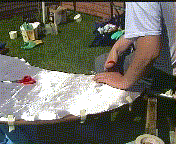
|

|

|
| Fibreglass matting cut to shape | Epoxying down the fibreglass matting | Fibreglass ribbing along the Rudder outer edges |
11/7/94
Set up the workshop etc in the garden and proceeded further laminates on the rudder. Had to spend two hours just sanding down both sides and edges of the rudder. Our 1st laminate was really too much epoxy, 2nd laminate on the other side was much easier to sand down. Next was to laminate the Stainless Steel shaft edge. Managed to stand the rudder on end to do this. Again weather warm today and epoxy was getting too hot too quickly. Moved the containers into the shade. It almost ruined another brush. It is only good for expanding foam in this condition. Laminating portside worked better, fewer air bubbles to deplete.
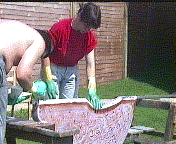
|

|
|
| Fibreglass ribbing along the Rudder shaft edge | Getting there, but still not finished. Needs more layers on. |
12/7/94
Started out to be another heatwave. Decided to move the rudder into the shade for epoxying. Sanded down starboard side especially where air bubbles where over the nail heads from the 1st laminate. Dug out the air bubbles to full them with epoxy. Layed out and finer shaped the last of the cut up fibreglass matting pieces, then laminated it in place, filling the nail head cavities aswell. By now 13:30pm and sun now onto the rudder. It did not take long to cure. Wind bit stronger today and overcast. Next stood the rudder on its end and with some narrower tape, this time 74mm (Used 100mm last time), epoxied a length over the stainless steel shaft. Once this almost cured, cut two short lengths and laminated one each end of the rudder over the shaft, and side lengths over the wood both sides. Then with two more short lengths. One cut into two and shaped , epoxied these around the lower end of the shaft, to build up the bottom edge of the fibreglass. Used masking tape to mark where the fibreglass to stop. It is now 18:00pm very cloudy and overcast, and temperature dropped when sun disappeared. A strip on the outer edge is next on the agenda then a third laminate all round. Forecast is rain tomorrow so we will have to see.
13/7/94 thru 15/7/94
Seemed to be a monotonous routine. Out with the rudder, spend hours sanding down the previous days epoxy , then epoxy up again. Extensively built up the upper and lower rudder ends around the shaft. Working at tressle height, we were working bent over. My was it painful to stand up straight again. Weather these three days, sunny warm and with overcast spells. We had to be careful not to get sunstroke. With the heat and fibreglass dust we both felt up and down. It takes two to keep the spirits up and the enthusiasm going. It had not been easy this rudder has been a trial of endurance for both of us. Going down to the boat Saturday. See if there is any feed back from John H.
16/7/94 thru 17/7/94
Worn out after doing the rudder only to take it with us for a fitting. Had it in and out twice. Needed to trim the fibreglass at both ends just a touch so it does not rub . Laid carpet down the hole to help protect the rudder. It is a dead weight now and not at all easy to cart around. Visited Les H as John H was not seen this weekend. Turned out John H on Holiday now for two weeks, but even after Les H had talked to John H, John H was adamant about sticking to his agreement and still wants us out. It is disappointing really. We have been let down totally. Like father like son not in this case. For us so much to do and can we do it in time before moving. Sanded down the original main bulk head laminate and cleaned up the other bulk head areas. The bilge paint had already been ground down Then managed to cut the fibreglass foam and pack the portside of the main bulk head. Needed to re-align the bulk-head to marry up the centre edges. Then laminated with three layers of ribbon this port main bulk-head. Very tedious job. Almost three hours in total. Epoxy had to be done in small batches (2 plunges), as temperature was reducing working time and the pot-life drastically. Just had enough jugs to do 7 batches in a run. Both of us felt ill afterwards with epoxy fumes and acetone fumes, in a confined space, and there was little wind around today. Left the boat about 20:00pm.
18/7/94
Sorted out our shed at home to make space for bringing back timber from the workshop.
19/7/94
Concern this week was hatch glass which had smashed and needed a replacement. Tried several local glass places with no success then rang Timage, from whom we had bought the hatch , and they were able to assist. They could send us replacement glass and the rubber. Traced the glass pattern onto a sheet of A3 paper. Wrote a letter and a cheque and got a package posted off to Timage.
22/7/94
Had been giving lots of thought to where we were going to take the boat, and in the end we decided the best option would be to take her to a proper boatyard. 13:00pm set off for the Marina and searched out the Marina Manager in the Capitainnery. They seemed very easy and relaxed. No problem with space. We can do what we want just clean up afterwards and dont upset anyone else. There are a couple of long term projects going on in the yard, others in the sheds. The sheds were expensive so had to settle for outside. Strong fibreglass smell plus seaweed etc. Parking the van up and using a workbench no problem etc. Water is free. Electric on meter. Both of us excited at the prospect. We cant wait now. Strolled around the whole marina. Visited the Chandlery. The chandlery gave us phone number for sealant agents. We were looking for an oil based sealant to adhere the rudder shoe. Asked about copper rod, for making the rudder shoe studs. They suggested a Stainless Steel workers in the Marina Yard, who although they could not help us with rod, suggested a good place to try. They themselves do Stainless Fabrications up to 6mm. Thicker can be cut else where. Arrived back at the boat 18:00pm.
23/7/94
Contemplated going to search out the stainless steel/Rod place mentioned yesterday but Lance not too good today, and it was midday already. Remove all paper and plastic from all the workshop sheeting. The temperature was 30degrees in the boat and very little wind. We set to cutting and screwing into place the centre main-cabin deck ply. The main-cabin frontage is splitting on the upper edge therefore need to seal it in ASAP. 16:00pm now and tea-time. The centre main cabin deck ply has been planed, the beams marked onto it and the holes drilled and countersunk for the 22 gripfast nails on the forward and aft edges. It was so hot and sticky on the boat 30degrees again. Ruth was fanning Lance with a piece of foam to keep the enthusiasm bubbling. 18:00pm and we have planed up the rest of the narrow lengths of mahogany and Iroko. We should be able to take home quite a quantity of timber which has now been sorted and neatly stacked in boxes. It is 20:00pm now and we have planed up, sawn into two pieces and planed down to 45mm thickness one of the planks of Iroko. This is to be used for the cabin sole bearers. The timber is bowed a touch but should be able to get around that. It is far too seasoned really. No good for deck. Wonderful today no visitors. No doubt John H and all wont show their faces now until the last minute. In other words keep away leave us alone. Just what we asked of them in the first place. Got chinese and stayed in the workshop. Kept looking at the Iroko. Wont be much of it once it is cut and planed. Contemplated the use of it. The two planks planed today are hopefully for the cockpit sole bearers. These and the rest of the IROKO is bowed and will be moreso once it is cut into. Could use the rest of it for lining out cabin and saloon. It is too dry for exterior use.
- - - - - - This is the end of Diary Section 19 - - - - - -
![]()

